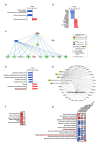Fasting pancreatic polypeptide predicts incident microvascular and macrovascular complications of type 2 diabetes: An observational study
- PMID: 38850100
- PMCID: PMC7617488
- DOI: 10.1002/dmrr.3829
Fasting pancreatic polypeptide predicts incident microvascular and macrovascular complications of type 2 diabetes: An observational study
Abstract
Aims: Pancreatic polypeptide (PP) is elevated in people with vascular risk factors such as type 2 diabetes or increased visceral fat. We investigated potential relationships between PP and microvascular and macrovascular complications of diabetes.
Materials and methods: Animal study: Subcutaneous PP infusion for 4 weeks in high fat diet mouse model. Retinal mRNA submitted for Ingenuity Pathway Analysis. Human study: fasting PP measured in 1478 participants and vascular complications recorded over median 5.5 (IQR 4.9-5.8) years follow-up.
Results: Animal study: The retinal transcriptional response to PP was indicative of cellular stress and damage, and this footprint matched responses described in previously published studies of retinal disease. Of mechanistic importance the transcriptional landscape was consistent with upregulation of folliculin, a recently identified susceptibility gene for diabetic retinopathy. Human study: Adjusting for established risk factors, PP was associated with prevalent and incident clinically significant retinopathy (odds ratio (OR) 1.289 (1.107-1.501) p = 0.001; hazard ratio (HR) 1.259 (1.035-1.531) p = 0.0213), albuminuria (OR 1.277 (1.124-1.454), p = 0.0002; HR 1.608 (1.208-2.141) p = 0.0011), and macrovascular disease (OR 1.021 (1.006-1.037) p = 0.0068; HR 1.324 (1.089-1.61), p = 0.0049), in individuals with type 2 diabetes, and progression to diabetes in non-diabetic individuals (HR 1.402 (1.081-1.818), p = 0.0109).
Conclusions: Elevated fasting PP is independently associated with vascular complications of diabetes and affects retinal pathways potentially influencing retinal neuronal survival. Our results suggest possible new roles for PP-fold peptides in the pathophysiology of diabetes complications and vascular risk stratification.
Keywords: diabetes mellitus; diabetic retinopathy; microvascular disease; pancreatic polypeptide; visceral adiposity.
© 2024 The Author(s). Diabetes/Metabolism Research and Reviews published by John Wiley & Sons Ltd.
Conflict of interest statement
The authors report no conflicts of interest.
Figures




Similar articles
-
Macrovascular and microvascular complications in US Medicare enrollees with type 2 diabetes with and without atherosclerotic cardiovascular disease.Diabetes Obes Metab. 2025 Aug;27(8):4137-4147. doi: 10.1111/dom.16441. Epub 2025 May 7. Diabetes Obes Metab. 2025. PMID: 40341754 Free PMC article.
-
Intensive glucose control versus conventional glucose control for type 1 diabetes mellitus.Cochrane Database Syst Rev. 2014 Feb 14;2014(2):CD009122. doi: 10.1002/14651858.CD009122.pub2. Cochrane Database Syst Rev. 2014. PMID: 24526393 Free PMC article.
-
Blood pressure control for diabetic retinopathy.Cochrane Database Syst Rev. 2015 Jan 31;1:CD006127. doi: 10.1002/14651858.CD006127.pub2. Cochrane Database Syst Rev. 2015. Update in: Cochrane Database Syst Rev. 2023 Mar 28;3:CD006127. doi: 10.1002/14651858.CD006127.pub3. PMID: 25637717 Free PMC article. Updated.
-
Fasting and fasting-mimicking treatment activate SIRT1/LXRα and alleviate diabetes-induced systemic and microvascular dysfunction.Diabetologia. 2021 Jul;64(7):1674-1689. doi: 10.1007/s00125-021-05431-5. Epub 2021 Mar 26. Diabetologia. 2021. PMID: 33770194 Free PMC article.
-
Trace elements and risk of diabetes-related vascular complications: results from the EPIC-Potsdam cohort study.Cardiovasc Diabetol. 2025 Jul 24;24(1):302. doi: 10.1186/s12933-025-02861-y. Cardiovasc Diabetol. 2025. PMID: 40707897 Free PMC article.
Cited by
-
Role of DPP-4 and NPY Family Peptides in Gastrointestinal Symptoms Associated with Obesity and Type 2 Diabetes Mellitus.Medicina (Kaunas). 2025 Mar 15;61(3):504. doi: 10.3390/medicina61030504. Medicina (Kaunas). 2025. PMID: 40142315 Free PMC article.
References
-
- Boussageon R, Bejan-Angoulvant T, Saadatian-Elahi M, et al. Effect of intensive glucose lowering treatment on all cause mortality, cardiovascular death, and microvascular events in type 2 diabetes: meta-analysis of randomised controlled trials. Br Med J Abstr. 2011;343(jul26 1):d4169. doi: 10.1136/bmj.d4169. - DOI - PMC - PubMed
-
- Chew EY, Davis MD, Danis RP, et al. The effects of medical management on the progression of diabetic retinopathy in persons with type 2 diabetes: the Action to Control Cardiovascular Risk in Diabetes (ACCORD) Eye Study. Ophthalmology. 2014;121(12):2443–2451. doi: 10.1016/j.ophtha.2014.07.019. - DOI - PMC - PubMed
-
- Zhong P, Tan S, Zhu Z, et al. Normal-weight central obesity and risk of cardiovascular and microvascular events in adults with prediabetes or diabetes: Chinese and British cohorts. Diabetes Metab Res Rev. 2023;39(8):e3707. - PubMed
-
- Anan F, Masaki T, Ito Y, et al. Diabetic retinopathy is associated with visceral fat accumulation in Japanese type 2 diabetes mellitus patients. Metabolism. 2010;59(3):314–319. - PubMed
Publication types
MeSH terms
Substances
Grants and funding
LinkOut - more resources
Full Text Sources
Medical
Miscellaneous

